 Investing in community digital infrastructure is a low-risk impact investment with steady returns – and a solid alternative to traditional investments where there is increasing volatility (stock markets), uncertainty (e.g. oil and gas industry), or marginal yields (investment grade bonds). Private investors and patient capital are part of the solution for communities.
Investing in community digital infrastructure is a low-risk impact investment with steady returns – and a solid alternative to traditional investments where there is increasing volatility (stock markets), uncertainty (e.g. oil and gas industry), or marginal yields (investment grade bonds). Private investors and patient capital are part of the solution for communities.
Patient capital enables pivoting to an economic case for investing in community digital infrastructure, capturing new revenues from local economic growth by growing the local economy through broadband and digital transformation. Revenue from increased local economic activity is captured through additional subscriptions (higher take-rates), higher value-subscriptions, and value-added services.
An economic case for investing in digital infrastructure is what communities and the broadband industry have been waiting for – now it is time to execute. The COVID-19 pandemic has sharpened the argument that the case for broadband is not just economic – but existential. Elected officials, local decision-makers, and community leaders have to understand that:
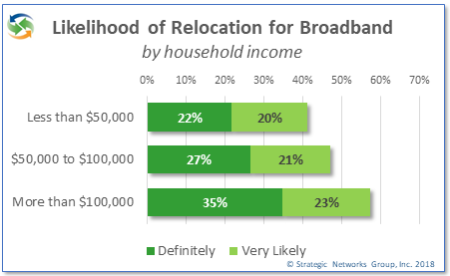 Investing in broadband cannot be put off. Leaders can no longer wait for their replacement to take on a broadband initiative. Even if they do not have the experience, know-how, or time left in their term – their community needs reliable broadband now.
Investing in broadband cannot be put off. Leaders can no longer wait for their replacement to take on a broadband initiative. Even if they do not have the experience, know-how, or time left in their term – their community needs reliable broadband now.- The need is real and growing —the escalating transition of work, healthcare and education to a digital platform means that broadband can no longer be considered a luxury, it is essential to competitiveness and sustainability. Heavily increasing network traffic and burdening networks that were not built for such loads.
- A new norm has emerged — COVID-19 is driving home the reality that gaps in broadband access, quality, and affordability are endangering the very survival of citizens and businesses in communities that do not have digital infrastructure.
Communities seeking better broadband need solutions now. Investors are looking for steady returns. SNG has established an economic case to engage investors and bring private capital to deliver community digital infrastructure, digital transformation, and workforce development.
We start with digital infrastructure for the new economy, which is more than simply fast internet access. Community digital infrastructure is a network platform that connects all residents and businesses (like roads) so that every community member can access and effectively participate in the increasingly online economy. Digital transformation and workforce development increase local innovation and digital inclusion, which grow the local economy and workforce – whose growth further expands the local market for broadband and value-added service revenues for the digital infrastructure network. This virtuous cycle yields indirect community benefits, such as local business retention and growth, new good-paying local jobs, increased local GDP and tax base, increased autonomy and quality of life, among many others.
You have a new way to bring private capital and community digital infrastructure together and get this done.

 SNG Research Brief – Broadband Impact on Household Income
SNG Research Brief – Broadband Impact on Household Income
Household uses of the internet are often seen as lifestyle enhancements or conveniences, such as online entertainment, social networking, paying bills, or simply browsing for information on topics of inetrest. However, a significant number of households also use the internet to generate income, ranging from small amounts of supplementary income to full time home business income.
More than entertainment and social apps
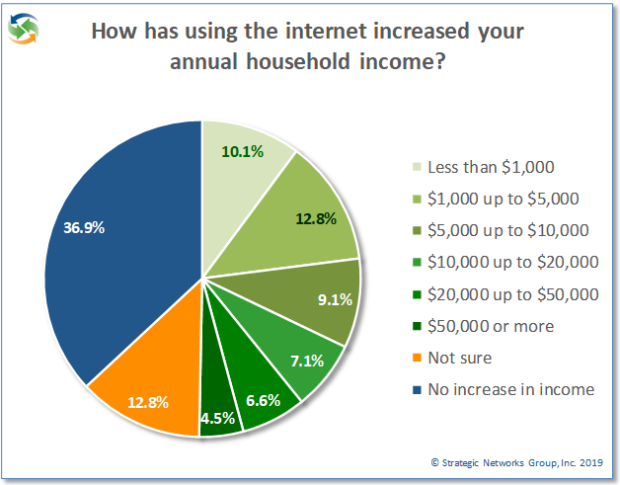 SNG’s research of more than 18,000 households shows that 89% have a personal web presence and, while the majority use this for personal or professional networking, more than 30% of these households use their web presence to generate income. Overall, more than 50% of households report that the use of broadband has enabled them to increase their household income in one way or another. 29% earn substantial supplementary income of between $1,000 and $20,000 annually, while another 12% earn more than $20,000 annually. At whatever level of additional income, it can make a huge difference to the lifestyle of most people, and households are finding ways to use the internet and their broadband connections to make it happen.
SNG’s research of more than 18,000 households shows that 89% have a personal web presence and, while the majority use this for personal or professional networking, more than 30% of these households use their web presence to generate income. Overall, more than 50% of households report that the use of broadband has enabled them to increase their household income in one way or another. 29% earn substantial supplementary income of between $1,000 and $20,000 annually, while another 12% earn more than $20,000 annually. At whatever level of additional income, it can make a huge difference to the lifestyle of most people, and households are finding ways to use the internet and their broadband connections to make it happen.
The two most obvious ways that the internet and broadband connections can be used to generate household income are teleworking and home-based businesses. These create income directly from employment and from business activities respectively. However, even excluding these households more than 41% of the remainder still generate additional household income online in amounts large and small.
It is no surprise, then, that more than 50% of households see the ability to work from home as a significant benefit of broadband, and 37% say that the opportunity to earn additional income is a very significant benefit. While there are many other lifestyle benefits from broadband that rate higher across all households, one should not underestimate the significance and impact of how many households use broadband to create household income.
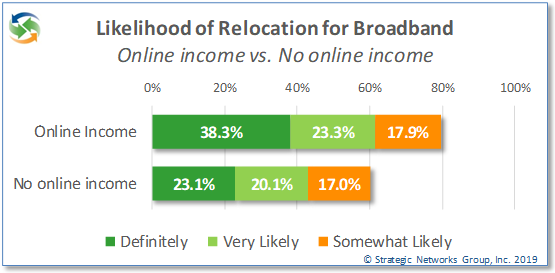 When you have income generation, access to the internet with quality broadband becomes much more than a “nice to have”. Households see the value in this and community leaders need to recognize this as well. In fact, the likelihood of relocating for quality broadband is significantly higher for those generating income online compared to households that do not. These are innovative households that communities can ill-afford to lose.
When you have income generation, access to the internet with quality broadband becomes much more than a “nice to have”. Households see the value in this and community leaders need to recognize this as well. In fact, the likelihood of relocating for quality broadband is significantly higher for those generating income online compared to households that do not. These are innovative households that communities can ill-afford to lose.
Broadband enhances the workforce
While earning additional household income is significant, the majority of working households still have one or more members employed at jobs, either at an employer establishment or by teleworking. Having access to quality broadband helps households improve their employment in two important ways. First, broadband provides access to online training and education for enhancing skills and learning new ones. Second, with access to a world of opportunities the internet helps people find better jobs, including the ability to telework rather than relocate.
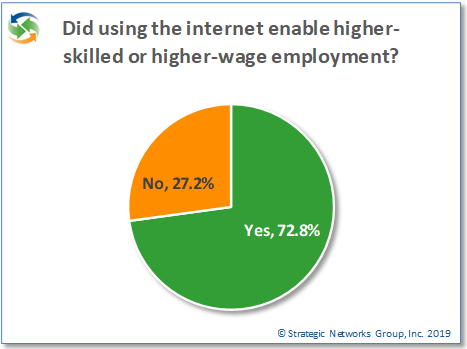 More than 45% of households use the internet for education or training courses. Of these, 45% strongly agree that online education provides access to more learning opportunities and more than 30% say that online training enabled the completion of a degree or certification. It is significant that broadband can make such a potential difference to the livelihood of one in seven households.
More than 45% of households use the internet for education or training courses. Of these, 45% strongly agree that online education provides access to more learning opportunities and more than 30% say that online training enabled the completion of a degree or certification. It is significant that broadband can make such a potential difference to the livelihood of one in seven households.
Of those households that had a member finding new employment, 73% said that using the internet helped them to gain better employment in higher-skill or higher-wage jobs, with 20% of those households using telework.
Broadband enables people to enhance their skills wherever they live and to find better employment while remaining in their community. These benefits of broadband do not impact every household since not everyone is equally motivated to follow these paths, but broadband makes it possible for those who do.
See what broadband means for a rural county and how they got the support and funding to build the digital infrastructure they need to thrive – Custer County Broadband Impact and Market Assessment.

Find out more about SNG Solutions for Local Economic Development.

 SNG Research Brief – Teleworking
SNG Research Brief – Teleworking
Teleworking is not for everyone, nor is it available to everyone in their job. However, a growing number of people telework part or all of their work week. We define telework as working at your job from home in a formal arrangement with the employer during normal working hours, as opposed to simply accessing the workplace remotely on an occasional basis or while traveling.
Teleworking offers tremendous potential for people to be employed in the type of job they want and to live in the community they prefer, but to telework effectively people need robust and reliable broadband connections. So, what is the current state of teleworking and what is its impact on teleworking households and the community? SNG has compiled important teleworking insights from research of over 18,000 households.
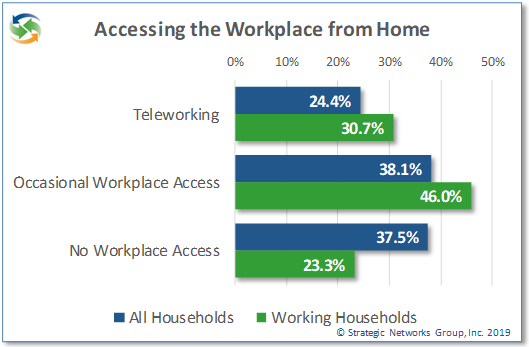 Nearly one in four households (24.4%) include one or more teleworking members. An additional 38% of households access the workplace from home on an occasional basis. These numbers increase to 31% and 46% for employed, working-age households. The vast majority of those employed use home internet for work reasons to some degree.
Nearly one in four households (24.4%) include one or more teleworking members. An additional 38% of households access the workplace from home on an occasional basis. These numbers increase to 31% and 46% for employed, working-age households. The vast majority of those employed use home internet for work reasons to some degree.
There is a significant difference between urban and rural households in accessing the workplace from home. Occasional workplace access is 6 percentage points lower for rural households, and teleworking is 9 percentage points lower. There can be a number of reasons for this difference, but one factor is the availability and quality of broadband in urban versus rural communities, as discussed in our research brief on household broadband. While teleworking offers the same benefits whether in an urban or rural community, it can be of particular value to rural residents who have a more limited range of local employment opportunities than their urban counterparts.
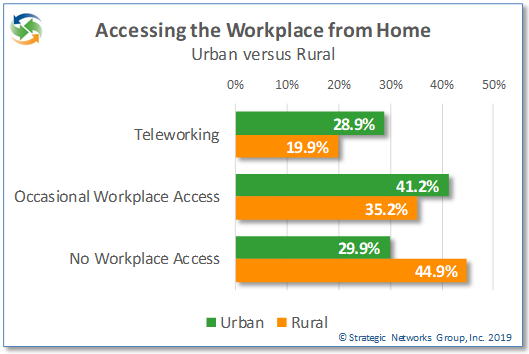 44% of teleworkers spend at least 4 days per week working from home, with an average of 3.2 days per week teleworking. The average one-way commute avoided is 60 miles (100 km) with almost one-third of teleworker living more than 60 miles from their employer workplace. Those with more distant commutes tend to telework more days per week. Nearly 75% of teleworkers say that reducing their time commuting is a very important benefit. This not only reduces commuting time, but reduces costs for fuel and car maintenance while reducing traffic, road wear, and fuel emissions.
44% of teleworkers spend at least 4 days per week working from home, with an average of 3.2 days per week teleworking. The average one-way commute avoided is 60 miles (100 km) with almost one-third of teleworker living more than 60 miles from their employer workplace. Those with more distant commutes tend to telework more days per week. Nearly 75% of teleworkers say that reducing their time commuting is a very important benefit. This not only reduces commuting time, but reduces costs for fuel and car maintenance while reducing traffic, road wear, and fuel emissions.
Not just a convenience
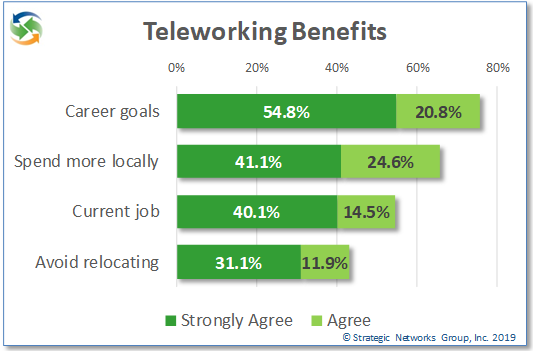 Teleworking is not merely a convenience and cost saving for households, although these are important benefits. More than half of teleworkers strongly agree that their ability to telework in their job helps in achieving their career goals. 40% strongly agree that they would not have their current job were it not for teleworking and 31% strongly agree that they would need to relocate for their job if they could not telework.
Teleworking is not merely a convenience and cost saving for households, although these are important benefits. More than half of teleworkers strongly agree that their ability to telework in their job helps in achieving their career goals. 40% strongly agree that they would not have their current job were it not for teleworking and 31% strongly agree that they would need to relocate for their job if they could not telework.
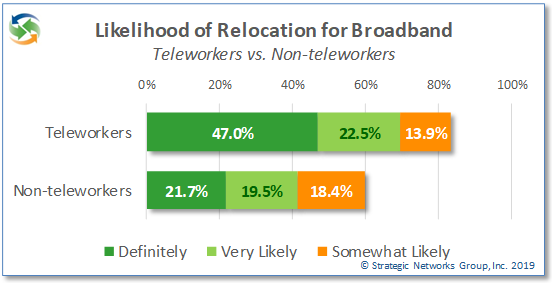 For those currently teleworking, their ability to do so is an important factor in being able to remain in their community while employed in a job that meets their goals. Having access to quality broadband is essential for people to effectively work from their home office. In fact, the likelihood of household relocation to get quality broadband service is more that twice as high for teleworking households than for non-teleworking households, with 47% saying they would definitely relocate for broadband versus 22% of non-teleworkers. (For more on this, please read our research brief on Broadband Importance to Household Location.)
For those currently teleworking, their ability to do so is an important factor in being able to remain in their community while employed in a job that meets their goals. Having access to quality broadband is essential for people to effectively work from their home office. In fact, the likelihood of household relocation to get quality broadband service is more that twice as high for teleworking households than for non-teleworking households, with 47% saying they would definitely relocate for broadband versus 22% of non-teleworkers. (For more on this, please read our research brief on Broadband Importance to Household Location.)
An unsung community asset
The significance of this for communities is that those households who may want to telework and have the opportunity to do so may need to either forgo those employment opportunities or relocate out of the community if they do not have the quality of broadband they need. By the same token, those who may want to locate into the community for its other attractions will be inhibited to do so if the available broadband does not allow them to telework effectively. While teleworking only impacts a portion of the population, it is a significant portion and a lack of quality broadband can have noticeable consequences for attraction and retention of households.
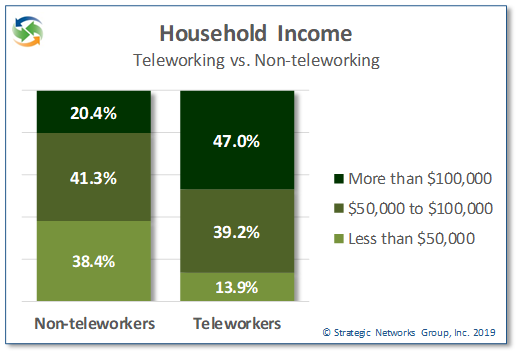 Not only is the teleworking household segment a significant percentage of the community, it is a highly valuable segment. Teleworking households have significantly higher incomes than non-teleworking households, with 47% having a household income of more than $100,000 per year compared to 20% of non-teleworking households. 86% earn more than $50,000 per year.
Not only is the teleworking household segment a significant percentage of the community, it is a highly valuable segment. Teleworking households have significantly higher incomes than non-teleworking households, with 47% having a household income of more than $100,000 per year compared to 20% of non-teleworking households. 86% earn more than $50,000 per year.
Households with higher incomes spend more locally, own more valuable properties, and pay higher taxes locally. While communities cannot create teleworking employment opportunities for residents, ensuring that they have the quality broadband needed sets the stage for having more residents telework and stay in the community, as well as attracting new teleworking residents.
Teleworking delivers benefits not only to those teleworking but also to the community by giving residents the option to find or keep the job they want while remaining in their community of choice. By working from home, teleworkers spend more time in their community, buy more locally, and are more engaged in the community. Communities that ensure they have quality, robust broadband provide a platform for teleworking and open up more opportunities for their residents and for attracting new residents.
See what teleworking means for a rural county and how they got the support and funding to build the digital infrastructure they need to thrive – Custer County Broadband Impact and Market Assessment.

Find out more about SNG Solutions for Local Economic Development.

 There are still far too many communities without broadband and funding agencies do not have enough money to fund all of the necessary digital infrastructure and last mile connectivity to individual premises. It is time to start looking at different ways to deploy broadband into unserved and underserved areas.
There are still far too many communities without broadband and funding agencies do not have enough money to fund all of the necessary digital infrastructure and last mile connectivity to individual premises. It is time to start looking at different ways to deploy broadband into unserved and underserved areas.
How can funding agencies get ten times more broadband coverage per tax dollar invested?
Localities without broadband will lose residents, businesses, and their tax base. How many communities exist today without roads, electricity, or water and sewer systems? However, areas remain unserved or underserved because there is not enough of a return (profit) for broadband service providers to justify the investment. Whether private, public, or private-public partnerships fund broadband, investments will need to be made and financed for such localities to survive, let alone thrive. A pivot in approach is needed to approach broadband as digital infrastructure.
Current Investment Challenges with Broadband Planning and Investment
- Unserved and underserved areas exist because there is not enough of a business case (profit) for private sector providers to invest
- Many of the unserved or underserved localities have limited resources (financial and staffing) and expertise to develop comprehensive broadband plans that are economically sustainable
- Inertia and gridlock that leads to accepting the status quo after spending time and money on traditional feasibility studies that are fundamentally flawed in trying to make a private sector business case for broadband where none exists.
Broadband Funding Program Challenges
When broadband funding is available, how can funding agencies determine whether:

- Community leaders are staffed and prepared to develop and launch a sustainable solution? In other words, are they committed and ready?
- The project is comprehensive and sustainable
- Potential project risks can be identified to avoid pitfalls, or unsustainable networks that do not resolve the lack of broadband access
- Public funds invested will generate the greatest local economic impacts and community benefits
Digital Infrastructure
Broadband, like roads, is essential infrastructure. Retaining businesses, jobs, and population are all benefits that broadband enables for a locality, but are off-balance sheet to private sector providers. That is why broadband needs to be approached as digital infrastructure – it has become an essential service. Governments invest in infrastructure because there are public benefits that private sector entities cannot monetize – these are externalities, or what we at SNG also call community benefits.
Economic and community development agencies know they must address broadband gaps if their localities are to remain viable. For example, despite fiscal constraints and resistance to public investment in broadband by vested interests, States are allocating $10million, $20million or $100 million to broadband, which are significant legislative wins. However, if the cost to expand broadband to unserved areas is $1.3 to $1.7 billion (as was with the State of Tennessee), it will take at least a decade if reliant upon state funding at those levels – and no community can afford to wait five to ten years for broadband. Anyone that can leave, will have left for better education, healthcare, public safety, economic opportunities, and overall quality of life. Businesses and high value individuals will be very difficult to retain, let alone attract. Struggling localities will continue an accelerating downward spiral.
In the absence of funding private sector investment, municipalities have tried to establish a municipal or utility-based ISP, taking on a bad business case while directly competing with incumbents. Often these projects are locked into the traditional mindset of building a municipal retail ISP as “The” solution. Some have been successful, most have struggled. In many States municipalities are prohibited or severely restricted in taking this retail ISP services approach.
Another approach is funding projects using private service providers to deploy to unserved areas, typically with matching funding. Preference is given to those projects that offer the greatest matching funding to State dollars. This may be straightforward and may ‘check the box’ for broadband service, but choosing one provider to build-out to an area is essentially using public funds to subsidize one provider among many. While it may be compelling for practical reasons, this approach assumes that private providers can and will execute quickly with deployments, as well as provide competitive levels of service to address local broadband demand – current and future. However, subsidizing one service provider in a market tilts the playing field and inhibits healthy competition. Furthermore, problems can arise when profit-driven service providers interests do not align with a locality’s interests and needs – such as deploying smart community services.
Without other options, localities will continue to see under-investment in digital infrastructure even when community benefits outweigh private sector returns on investment.
Investing in Digital Infrastructure Planning
A more recent strategy is investing in digital infrastructure planning which enables funding agencies to leverage ten times what they are currently receiving from their broadband investments. The ten-fold (10x) difference is funding a network build (e.g. $1M for Ammon, Idaho) versus investing in planning to self-finance digital infrastructure (e.g. $100K). Funding agencies can get greater leverage from their broadband investment dollars by helping communities take the right action to invest in their own digital infrastructure than they do by investing directly in that infrastructure themselves.
 The challenge with developing a Digital Infrastructure Strategy for Communities and Regions is that they need help in understanding how this model can work and they need technical assistance to take initial steps. The starting point is assessing potential municipal cost reductions, subscriber savings, local economic growth, and smart community service benefits. When these community benefits outweigh digital infrastructure costs, it is possible to self-finance. For example, when telecom and internet costs can be reduced by 86% (see economic case of Ammon, Idaho) those municipal cost reductions are existing budgets that can be reallocated to finance the digital infrastructure investment.
The challenge with developing a Digital Infrastructure Strategy for Communities and Regions is that they need help in understanding how this model can work and they need technical assistance to take initial steps. The starting point is assessing potential municipal cost reductions, subscriber savings, local economic growth, and smart community service benefits. When these community benefits outweigh digital infrastructure costs, it is possible to self-finance. For example, when telecom and internet costs can be reduced by 86% (see economic case of Ammon, Idaho) those municipal cost reductions are existing budgets that can be reallocated to finance the digital infrastructure investment.
Funding agencies can play a critical role in broadband funding and policies. They can invest in communities rather than a network build. Broadband and digital infrastructure are not ends in themselves, but means to enable good-paying local jobs, grow local economic opportunities, and enhance local quality of life.
What can funding agencies do? A pragmatic, evidence-based approach is needed to make important decisions on broadband funding awards, while minimizing additional work for localities. Furthermore, with uncertainty on the level of broadband funding that will be available, an arms-length, objective process to assess and rank potential projects is needed to:
- Prioritize where funding should be invested for projects that are essentially ‘ready to go’ because they can be self-financed based on economic feasibility and community returns on investment (retaining and growing local business and jobs, access to health and educational services, etc.). These projects would get help with planning, getting started, and implementing a digital infrastructure approach – which is a more efficient use of State dollars when planning costs one-tenth as compared to directly investing in infrastructure.
- More efficient use of public dollars by investing in planning and demand aggregation enables areas to self-finance their digital infrastructure allows the remaining available public dollars to be allocated to areas that have the greatest need, but who may not have the means to address their needs themselves.
- Determine how funding be more efficiently and effectively spent (infrastructure, technical support, demand aggregation, etc.) based on each area’s identified needs, thereby maximizing community benefits per State dollar invested.
A funding agency’s role is most valuable in helping achieve economic and community development goals, while ensuring communities are ready and have the means to implement sustainable digital infrastructure plans.
Maximizing community benefits per broadband dollar invested
How can funding agencies determine where, when, and how to invest to address digital infrastructure needs of communities?
The first step is for communities to answer the question: Do the community benefits from a digital infrastructure investment outweigh the costs for the community/region?
Based on SNG’s long track record and unique experience in working with funding agencies in this way, we recommend the following:
- Assess Economic Feasibility of broadband infrastructure and whether potential community benefits outweigh costs over longer term (e.g. 15-20 years)
- Create a process for communities to self-opt in by providing a standardized input form localities can complete and provide the necessary information
- Those communities that have provided their information will receive an assessment of economic feasibility for their community or region – an arms-length assessment to support their broadband planning. Additionally the localities will have a geographically based phased plan based on estimated demand — to ensure their broadband planning is demand driven.
Outcome from Assessing Economic Feasibility: The funding agency will have an assessment of potential returns from broadband investment for each community / region, which can be ranked in terms of cost-benefit ratios and project sustainability. Additionally, identified municipal cost reductions can be used as matching funds for grant applications. See example of job and business impacts assessed for Custer County, Colorado.
- For communities that have participated in the economic feasibility assessment and their proposed projects prove to be sustainable, invite local leadership (council, broadband committees, etc.) to take the Community Readiness for a Digital Future
- Leadership teams from each community / region take 10-15 minutes to complete an online survey with objective metrics to assess whether or not they are doing the right things needed to get their project across the finish line. It also uncovers different perspectives between stakeholders – is there alignment, or are there gaps in their perspectives and/or approach? Time, money, and political capital can be saved by uncovering and addressing previously unseen gaps.
Outcome from Assessing Readiness: The funding agency receives a readiness summary of communities and regions who may require broadband funding. This enables the State to have a clear picture of which projects are ‘ready to go’ and which projects may require more preparation and technical support, which can be accompanied with broadband funding.
- Based on Economic Feasibility and Readiness findings, prepare a summative ranked list on impacts (increases in GDP, business and job growth, etc.) from State broadband investment dollars with details incorporated on the Readiness of each project – and if needed, how they can be helped to become ready and develop sustainable projects. This is critical input to the success of any broadband planning process at a community and regional level.
An implicit outcome of the steps described above is that communities will reveal their level of interest and commitment to act through their participation. While funding agencies can assist communities, it is essential that the local leaders are willing and able to take action. Funding agencies will know:

- Which communities have the greatest need for assistance
- What type of assistance they need
- How motivated they are to take action on their own behalf
- How ready they are to take action
- What next steps will be most effective for communities ready for assistance
Every community has different characteristics and faces different challenges. Those with the most need may not provide the greatest impact at a State level, but the benefits and impacts at a local level can be a matter of survival for a community or region. With relatively small investments the state can assist such communities to own their digital future and, collectively, the impact on the State can generate significant economic impacts without impractical and limited investments in the broadband networks themselves.
How can communities take control of their broadband future?
Many communities continue to struggle with inadequate broadband for their community. Residents and businesses cannot get the quality broadband they need, or any broadband at all. Municipalities are impeded or prohibited in providing new services and the local economy and overall community vitality suffers. Commercial ISPs are unwilling or unable to improve local broadband and yet resist attempts by communities or regions to take control of their broadband future.
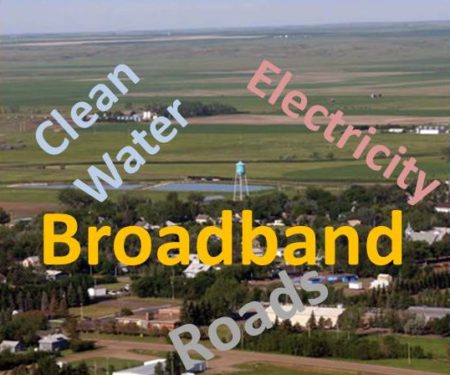 Standing still is not an option. The status quo will not change unless communities take the initiative. However, the most common approach to solving the problem is for municipalities to build and operate their own municipal broadband network. Credit to those that do this, but in many cases this becomes a continual struggle to avoid operating losses and recover the investment, while operating in the face of strong resistance and competition.
Standing still is not an option. The status quo will not change unless communities take the initiative. However, the most common approach to solving the problem is for municipalities to build and operate their own municipal broadband network. Credit to those that do this, but in many cases this becomes a continual struggle to avoid operating losses and recover the investment, while operating in the face of strong resistance and competition.
Here is the root problem. Commercial ISPs do not invest in network expansion or upgrades because there is not enough of a business case to do so for your area. They do not see the payback they need from that investment and they have already captured the most lucrative part of your market. This model of replicating the traditional ISP model and competing in the free market, albeit with more robust broadband, is really an ‘old school’ approach and one that will always be a struggle. You need to ask yourself …
“Can we really build and operate a profitable, competitive network when the incumbent providers, who already have networks and customers, don’t see the business case to invest any further?”
Fortunately, there is a better way available to any locality serious about owning its broadband future. It starts by recognizing and embracing broadband as the essential infrastructure of the 21st century. This approach is now possible because of maturing technologies that allow you to build open access virtualized networks that not only provide the digital infrastructure your community needs, but also is a platform that opens a marketplace for internet service providers. You put local users in control rather of their future than having them held hostage to whatever is available, and you can do this without becoming an internet service provider yourself.
Let’s go out on a limb and say that there is no municipal leader who wakes up one day and says, “What I really want to do is to become an ISP”. This is only a means to achieve your true goal, which is to ensure that everyone in your community can get affordable, quality broadband if they want it. It is about providing internet access, but it is also much more than that. It is about everything you can do with digital infrastructure and smart community services that will make your community a desirable place to live and do business.
It is time for a new approach … to change the paradigm based on a broader vision. To find out more read the full article “How can municipalities take control of their broadband future?”
 Investing in community digital infrastructure is a low-risk impact investment with steady returns – and a solid alternative to traditional investments where there is increasing volatility (stock markets), uncertainty (e.g. oil and gas industry), or marginal yields (investment grade bonds). Private investors and patient capital are part of the solution for communities.
Investing in community digital infrastructure is a low-risk impact investment with steady returns – and a solid alternative to traditional investments where there is increasing volatility (stock markets), uncertainty (e.g. oil and gas industry), or marginal yields (investment grade bonds). Private investors and patient capital are part of the solution for communities. Investing in broadband cannot be put off. Leaders can no longer wait for their replacement to take on a broadband initiative. Even if they do not have the experience, know-how, or time left in their term – their community needs reliable broadband now.
Investing in broadband cannot be put off. Leaders can no longer wait for their replacement to take on a broadband initiative. Even if they do not have the experience, know-how, or time left in their term – their community needs reliable broadband now.

 SNG Research Brief – Broadband Impact on Household Income
SNG Research Brief – Broadband Impact on Household Income




 SNG Research Brief – Teleworking
SNG Research Brief – Teleworking




 There are still far too many communities without broadband and funding agencies do not have enough money to fund all of the necessary digital infrastructure and last mile connectivity to individual premises. It is time to start looking at different ways to deploy broadband into unserved and underserved areas.
There are still far too many communities without broadband and funding agencies do not have enough money to fund all of the necessary digital infrastructure and last mile connectivity to individual premises. It is time to start looking at different ways to deploy broadband into unserved and underserved areas.
 The challenge with developing a
The challenge with developing a 
 Standing still is not an option. The status quo will not change unless communities take the initiative. However, the most common approach to solving the problem is for municipalities to build and operate their own municipal broadband network. Credit to those that do this, but in many cases this becomes a continual struggle to avoid operating losses and recover the investment, while operating in the face of strong resistance and competition.
Standing still is not an option. The status quo will not change unless communities take the initiative. However, the most common approach to solving the problem is for municipalities to build and operate their own municipal broadband network. Credit to those that do this, but in many cases this becomes a continual struggle to avoid operating losses and recover the investment, while operating in the face of strong resistance and competition.

